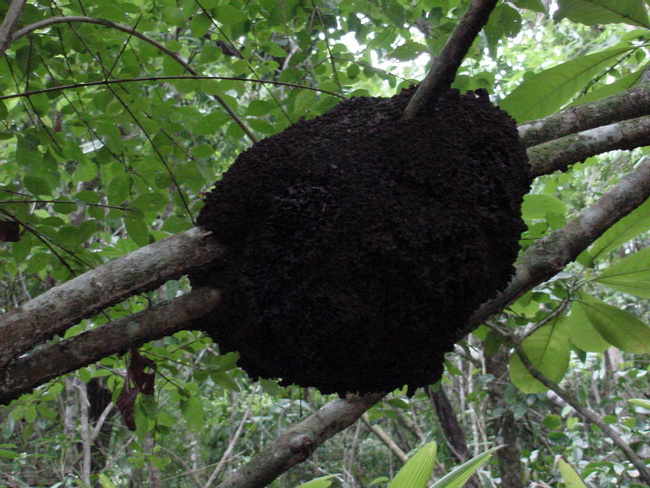
More about Arboreal Termites
Habitat
The termites in this genus can survive in trees in most lowland tropical habitats from rainforest to savanna to mangrove forest.
Range
These insects can be found along the lowlands of most of Central America.
Physical Description
The three castes of termites in a colony have very different functions and physiques. The soldiers have small brown bodies with dark heads and a long, pointed snout or beak used to squirt a defensive chemical. Workers are a similar size and shape, but have a rounded pale head and lack the squirting snout. The queen is enormous with an abdomen full of eggs and fat. She looks nothing like the workers and soldiers, but has a long yellowish body and cannot move herself.
Biology and Natural History
The most abundant tropical termites in the Americas, some Nasutitermes termites build their large, dark nests on tree trunks or large branches. Other termites in the same genus nest directly out from the ground, and there are species that even nest underground. A tree nest can be larger than a basketball, and up close looks like it is made out of sealed bits of paper. This is carton, a mixture of digested wood and termite feces that hardens into a strong, protective material.
The termites travel from the nest to rotting trees where they forage for food. They build tunnels covered in carton down the side of their home tree, over the forest floor, and to the food trees. The tunnels are distinctly a termite trait, which helps distinguish the termite nests from ant or wasp nests that can look similar high up in a tree.
One colony can have 5 or 6 thousand termites. One species, Nasutitermes corniger, can have giant nests with up to 1 million termites. Soldiers flood out of the nest when the colony is attacked, and expel a sticky, thick chemical called nasute glue from their snouts that smells like turpentine and is very irritating to the skin, particularly to the inside of the nose and mouth. This protection is effective against anteaters and several other predators. The workers, meanwhile, stay protected deep in the nest where they take care of the brood and the queen. They do not produce the nasute glue, but in swarms their biting can be a good deterrent. There is only one queen in the colony, and her job is mainly to produce eggs.
Diet
Arboreal termites get most of their nutrition from decaying wood material, which they chew up and bring back to the nest.
Height/Weight
Workers are 3 to 4 mm in length. Soldiers are approximately the same size. Queens can be 30 to 60 mm long.
Taxonomy
Order: Isoptera
Family: Termitidae
Sources
Hogue, Charles L. Latin American Insects and Entomology. University of California Press: Berkely and Los Angeles, 1993.
Kricher, John. A Neotropical Companion: an introduction to the animals, plants, and ecosystems of the New World tropics. Princeton University Press: Princeton, NJ, 1997.
-Amy Strieter, Wildlife Writer